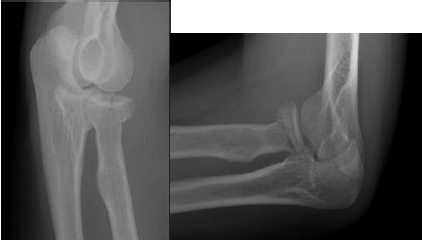Who is this leaflet for? What is its aim?
This leaflet gives advice on managing a radial head or neck fracture of the elbow, together with suggested exercises.

What is a radial head / neck fracture?
A radial head/ neck fracture is a break in one of the bones in your elbow.
This fracture is in a part of the bone that usually heals well with time and movement. It doesn’t need surgical treatment, plaster cast or bandaging and routine follow up is not required.
You can use a sling to hold your arm in a comfortable position for the first few days.
Swelling and bruising at the fracture site is normal. Simple, over the counter pain killers and icing the area will help to reduce swelling and pain. Apply the ice to the area indirectly (for example, by wrapping a bag of frozen peas in a towel) for 10 minutes 3–4 times a day.
You should:
- Reduce the wearing of your sling as your pain settles, and aim to completely remove the sling as soon as you feel able. Try to use it for less time each day.
- Gently stretch your elbow to regain full movement.
- Take simple, over the counter pain relief as needed to keep your elbow moving.
You should not:
- Drive whilst wearing the sling.
- Forcibly stretch your elbow as this is unnecessary and may cause pain, delaying your recovery.
How long will it take to get better?
The pain may take 3–6 weeks to settle down. It could be several months before the elbow feels normal again.
There may be slightly reduced movement at the elbow, especially when you straighten it, but this is unlikely to affect its function.
Should I do any exercises?
Yes! It is important to get your arm moving as soon as possible in order to regain normal movement.
You can do the following exercises immediately after your injury.
Try to do the exercises every 2–3 hours.
Exercise 1

- Sit with your elbow tucked in your side.
- Slowly turn your palm to the floor as far as you can.
- Then turn your palm to the ceiling as far as you can.
- Repeat 10 times or as many as you can comfortably tolerate.
Exercise 2

- Lie on your back.
- Bend your arm and point your elbow to the ceiling.
- Slowly straighten your elbow as if you are pointing to the ceiling, then lower back down trying to get your thumb down to the pillow.
- Repeat 10 times or as many as you can comfortably tolerate.
After an elbow injury your wrist and shoulder can become stiff. These daily exercises will help.
Exercise 3

- Keep your wrist mobile by moving it forwards and back and side to side.
Exercise 4

- Raise your arm overhead as far as you can comfortably. You can do this in any position, for example, lying / sitting / standing.
- You can have your elbow bent and / or in a sling for this exercise if it makes it more comfortable.
Is it normal to get pain when I exercise?
Yes, this is normal and may take several months to settle completely.
However, it should not be severe pain and any pain after exercising should be bearable.
Your elbow should not feel hot, inflamed or develop lots of swelling after exercising.
If your pain following exercising does not settle down within 30 minutes of exercising you should consider:
- Doing shorter bursts of exercises
- Not pushing into your pain too much
- Discussing your pain relief with your GP
If you still find your pain to be severe or unmanageable or are concerned about lack of improvement please contact the fracture clinic on 01223 348299 or your treating consultant.
How often should I exercise?
It is more effective to do small amounts of exercise regularly through the day.
This should mean your exercises are bearable and your arm does not stiffen up between sets.
Please contact your GP if your condition is not improving, or if your pain relief is not adequate.
If your condition is worsening please contact the Multi professional fracture clinic, call 01223 348299 or call 01223 257095.
For more information please visit Fracture Info (opens in a new tab)
We are smoke-free
Smoking is not allowed anywhere on the hospital campus. For advice and support in quitting, contact your GP or the free NHS stop smoking helpline on 0800 169 0 169.
Other formats
Help accessing this information in other formats is available. To find out more about the services we provide, please visit our patient information help page (see link below) or telephone 01223 256998. www.cuh.nhs.uk/contact-us/accessible-information/
Contact us
Cambridge University Hospitals
NHS Foundation Trust
Hills Road, Cambridge
CB2 0QQ
Telephone +44 (0)1223 245151
https://www.cuh.nhs.uk/contact-us/contact-enquiries/

